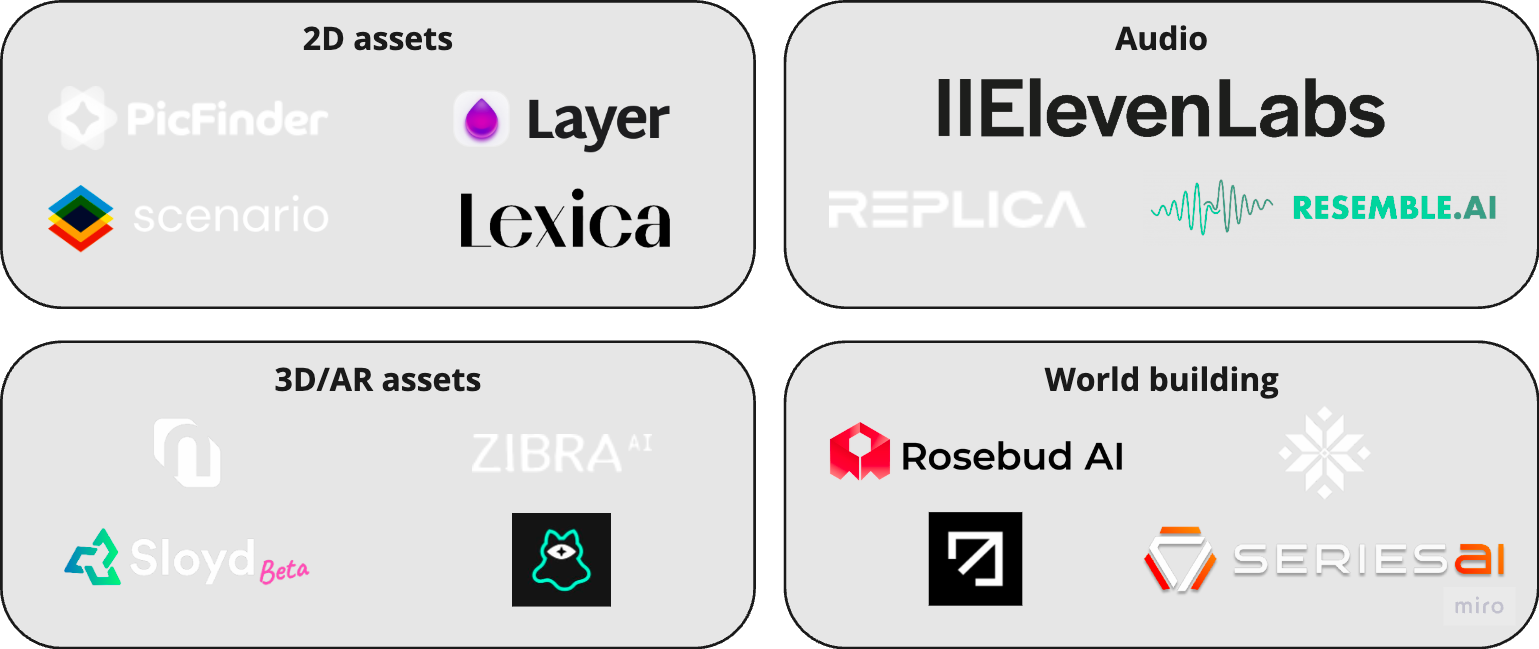AI in gaming: Why generative AI won’t transform game asset creation – yet
The transformative potential of gen AI in gaming is undeniable. But we see two areas beyond asset creation where it will have more impact.

Thanks to our MBA intern Dhruv Tandon, who co-authored this piece.
Gaming and AI go way back. 1972 saw the first example of AI being used to create a multiplayer game in Pong. 1982 brought in collision detection for NPCs and pathfinding – think Pac-Man: each ghost had a unique behaviour, with Blinky chasing Pac-Man, and Inky trying to position itself in front of Pac-Man. The ‘90s saw finite-state machines in games like Doom and Half-life. The 2010s showed the power of deep reinforcement learning with OpenAI’s agent, OpenAI Five, beating the best human opponents at Dota 2. Now we’re in the early days of LLMs.
The transformative potential of generative AI in gaming is undeniable. We’re already seeing the early impact of AI generation on code, 2D and 3D assets, avatars and autonomous agents, to entire games. In the long run, alongside the parallel development of AR and VR, it will transform all immersive 3D worlds.
From scale to intelligence
But the gaming industry has changed. It has transitioned from the ability to supply packaged goods at scale to developing intelligent, feedback-driven models in internet-based and mobile gaming. This shift has led to the emergence of new problem areas and opportunities in creating engaging IP with emergent gameplay, establishing strong feedback loops, and exploring alternative monetisation methods like skins and microtransactions.
With three billion gamers and the immersive content that gaming produces, creating new gaming infrastructure has massive potential to solve problems of tool fatigue, ballooning costs of production, marketing and live operations. With new platforms, new gameplay mechanics and new accessibility of gaming infrastructure, creators can push the envelope further to focus on creating content that monetises. At the same time there are new avenues to tap into discovery and distribution that did not exist ten years ago which are making infrastructure for gaming help thread needles to bundle a cross platform publishing, marketing and content generation strategy.
What opportunities are there for AI to solve these gaming infrastructure issues?
The hype and reality of AI asset creation
Being about 40% of most game budgets, asset creation remains the holy grail of gaming infrastructure. Most AAA studio gaming projects resemble construction projects, requiring huge up-front investment with no revenue until year three onwards. And the bulk of this is due to the amount of work that goes into developing the art pipeline.
Generative AI can be a big unlock here, driving content creation at lower cost and at scale. But the lack of quality and maturity today is making game studios hesitant.
Asset creation remains the biggest bottleneck to progress. While we are on the lookout for great AI tools to assist in this process, none of them are able to deliver the quality that we typically seek in a studio game.
– CTO at a F2P game development studio
AI has the benefit of being consistently, tirelessly average, but human artists have the potential to greatly outperform AI. And that’s vital when your product aspires to unique, highly detailed fictional worlds in which people want to invest their time and money.
This disparity is especially stark in complex tasks like rigging (where developers add a virtual skeleton inside a character model for movement) and fine tuning 3D assets. Navigating licensing and IP rights, particularly if you’re selling to large enterprises or big studios, adds another layer of complexity.
What will be more useful in the near-term for game studios is infrastructure that can help accelerate specific aspects of the production pipeline – focusing on tasks like rigging, variation and indexing, rather than trying to replace the creation process wholesale.

Generative AI tools, like Scenario, that can spin up style-consistent variations of existing assets, for instance, could cut down work that is typically outsourced to third-party agencies. AI could also revolutionise how assets are indexed and re-used, allowing studios to semantically search similar assets within their database and quickly re-use existing assets, reducing redundant work.
There are two other areas we think open up a lot of opportunity.
Live operations & engagement
Live operations, which involves balancing gameplay, managing game economies, and enhancing player engagement, is ripe for AI integration.
It’s a sizeable part of large internet games that have an element of user-generated content. This usually goes towards moderating the gameplay – the “spreadsheet” of a game – to make the gameplay fair and more rewarding, and cutting down on problems in balancing or the game economy.
A game’s economy is pivotal in shaping a virtual world, influencing every player's choices and actions. And a well-balanced economy ensures sustained engagement, immersion, and a sense of achievement. EVE Online is known to have one of the most sophisticated game economies, where factions war depending on the price of resources. There have been times where a major rebalance needed to be done in order to save the game from losing a majority of its players. And AXIE Infinity’s game economy completely collapsed due to a side chain vulnerability. Effective management of game economies can make or break a gaming company.
AI tools could play a crucial role in automating repetitive tasks in this process and balancing the game. AI can also be used to automate testing and spot vulnerabilities. AI agents can test games, perform live playthroughs, and, alongside human playtesters, rapidly identify and report bugs.
Cheating is also an unsolved issue – CS:GO has reported that one in three people playing their game are using some sort of cheating that assists performance – and undermines trust in competitive gaming. AI is already starting to help here, with Anybrain uses AI for real-time fraud detection and age control.
But the market for anti-cheat solutions, though deep, may not be broad. Popular multiplayer, competitive gaming is the only application where anti-cheat software is useful. It’s a critical but niche market, which calls into the question the potential for building venture-scale company.

Personalisation & analytics
AI can also enhance personalisation and analytics in gaming.
Personalisation and microtransactions are increasingly key drivers of revenue growth. User-generated content, like skins and mods, has helped make games more personal and more engaging. Games like Roblox and Minecraft exemplify the trend, combining user content and social gaming to cultivate large, active communities of gamers, thereby opening up new monetisation models.
So tools and platforms that enable detailed analytics and personalisation are pivotal, particularly for mobile game developers in a post-ATT world, where targeted user acquisition has become more challenging and cost pers install has skyrocketed. In this new environment, marketing strategies have to be sophisticated, personalised to keep acquisition costs low. AI that can help here will be useful.
Understanding and adapting to consumer preferences through marketability testing is now a critical aspect of mobile gaming. Gaming companies are already using tools like Geeklabs to understand the top-of-the-funnel analysis and AI-powered analytics platform Telescope Labs to understand more about engagement and retention. As the industry evolves, there is a growing need for more sophisticated tools that can automate and streamline processes like A/B testing, which are still predominantly manual and time-intensive.
Testing the marketability of different game mechanics remains our biggest challenge as the tools for building games have made things really simple.
– CEO of a mobile game development studio
The future of gaming infrastructure
The future of gaming infrastructure is intertwined with AI's evolving capabilities.
AI’s role in asset creation is promising but current limitations mean that the more immediate opportunities can be found elsewhere. Content variation and indexing, live operations and engagement, and increased personalisation through analytics emerge as more immediate opportunities, all offer tangible improvements to both game development and the gaming experiences.
This sort of behind-the-scenes functionality is already having a big impact, even if it isn’t immediately obvious to users. As Roblox CEO and co-founder David Baszucki recently noted, AI has improved personalised discovery, voice and text monitoring, asset monitoring, and quality of real-time natural translation on the Roblox platform.
The best gaming infrastructure companies will be those that enhance the art pipeline, personalise gaming experiences, automate live operations, support platform shifts, enable cross-platform gaming, cater to a range of gaming studios beyond AAA, and adopt revenue-sharing and non-upfront SaaS models for monetisation.
Links to mentioned companies
2D assets:
- PicFinder – Infinite image generation powered by AI.
- Layer AI – Create professional game art, without limits.
- Scenario – Craft unique and style-consistent game assets with custom-trained AI models.
- Lexica – Create or search for images.
3D/AR assets:
- Nuvo3D – 3D asset creation company.
- Zibra AI – Create gen AI powered VFX for your game.
- Sloyd – Generate 3D models. Fast.
- Versed – Turning words in worlds.
Audio:
- ElevenLabs – Generative voice AI.
- Replica Studios – AI voice actors for games, film, and animation.
- Resemble AI – Generative voice AI for enterprise.
Worldbuilding:
- Rosebud AI – Create and share game worlds instantly.
- Promethian AI – Artificial Intelligence that builds virtual worlds.
- Polygonflow – Add-on to Unreal Engine that helps build world environments using gen AI.
- Series AI – Creating studio quality games on an Indie budget.
Live operations & engagement:
- Slingshot – Building games with AI NPCs.
- Portal One – Supports gaming in live events.
- Anybrain - Cheat detection service for identifying game fairness vulnerabilities.
- Convai – Conversational AI for games.
Personalisation & analytics:
- Telescope Labs – Analytics for gaming companies combined with on chain data from crypto.
- Martian Lawyers Club – Using AI to create player personalisation systems in real time.
- GRAAI – Ingests data to make predictions about games through AI.

